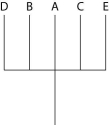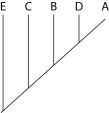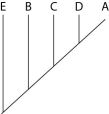Multiple Choice
The next questions refer to the following table, which compares the % sequence homology of four different parts (two introns and two exons) of a gene that is found in five different eukaryotic species. Each part is numbered to indicate its distance from the promoter (e.g., Intron I is the one closest to the promoter) . The data reported for species A were obtained by comparing DNA from one member of species A to another member of species A.
% Sequence Homology

-Based on the tabular data, and assuming that time advances vertically, which cladogram (a type of phylogenetic tree) is the most likely depiction of the evolutionary relationships among these five species?
A) 
B) 
C) 
D) 
Correct Answer:

Verified
Correct Answer:
Verified
Q34: The most important feature that permits a
Q35: <img src="https://d2lvgg3v3hfg70.cloudfront.net/TB5463/.jpg" alt=" Figure 26.3.
Q36: Traditionally, whales and hippopotamuses have been classified
Q37: Which of the following items does not
Q38: The following questions refer to this phylogenetic
Q40: Traditionally, zoologists have placed birds in their
Q41: Which kind of DNA should provide the
Q42: The term homoplasy is most applicable to
Q43: Which eukaryotic kingdom includes members that are
Q44: If, someday, an archaean cell is discovered